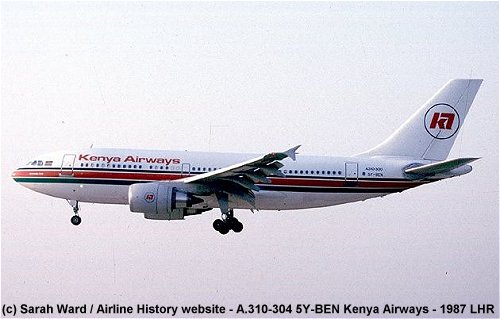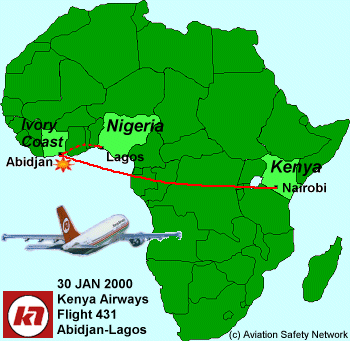
|
Five Years On, Cause of Mishap Unknown
|
|
|
|||||||||
|
|
||||||||||
The Nation (Nairobi)
January 30, 2005
Posted to the web January 31, 2005
Joseph Ngunjiri
Nairobi
Five years after the Kenya Airways flight KQ 431 crashed off the coast of Abidjan in Cote d'Ivoire, relatives of victims are yet to know the cause of the accident.
This despite the fact that the Kenya Government has the accident report which was handed over by the Cote d'Ivoire authorities in December 2003.

|
When the Sunday Nation contacted Mr Peter Wakahia, the Chief Inspector of Aircraft Accidents in Kenya, he said a comprehensive report of the crash, which killed 169 people, including 22 Kenyans, is in the "public domain".
If that is the case, why can't the same "public" access the contents of the report? Mr Wakahia clarified that the report was written in French.
"It is a tall order," he said. "We not only need to have persons conversant with the French language, but also knowledge of aviation technicalities."
 |
He said the '"fairly large" report is more than 170 pages. Mr Wakahia said the general thrust of the report indicated that the plane "collided with the sea", an explanation, he admitted, was "fairly obvious".
However, he called for patience and urged Kenyans to go with Transport Minister John Michuki's word that the report would be released "soon, when the whole composite picture will be made public".
What this means is that unless the report is translated into English, Kenyans and specifically relatives of those who perished in the crash, will remain in the dark as to the cause of the accident.
Under international aviation protocol, Cote d' Ivoire, the country where the crash occurred, should handle the investigation. However, Mr Wakahia said that French and Kenyan experts also lent a hand in the investigations.
In the early days, the West African government took the flak for not "concluding the investigations in good time".
It also happened that during the same time, Cote d'Ivoire was going through a political upheaval, which complicated the matter.
 |
However, when the report was handed over to the Kenyan authorities, a report in the Daily Nation of January 31, 2004, indicated that the issue of translation was not "a priority".
The long wait for the results of the investigation is now causing anxiety among the relatives, who feel that it has taken unnecessarily too long.
Nation Media Group's Edward Mwasi, who lost his brother in the crash, says: "We are very much interested in learning the truth so that these bad memories can finally go away."
"The long delay makes one suspicious. You might not even trust the report when it is finally released!" he said.
Jackie Obiero said: "We need to be told the truth so that our minds can rest."
Most of the victims' families have been compensated by Kenya Airways. The compensations were settled out of court.
According to International Intercarrier Agreement (IIA) on Passenger Liability, brokered by the International Air Transport Association, the airline should pay each victim at least $135,000, irrespective of the cause of the crash.
 |
Kenya Airways spent Sh71 million in airlifting relatives of the passengers to Abidjan to identify the dead.
However, the treaty sets no upper limit on the sums airlines may be ordered to pay when courts find them negligent, in the case of fatal accidents.
Airline experts noted that in order to escape liability, Kenya Airways needed to prove that the accident resulted from factors wholly unrelated to its crew's action or the aircraft's performance.
So, in the absence of a comprehensive report, there is no knowing whether the crash was a result of sabotage, human error, mechanical error or even plain negligence.
Making an initial response in Parliament regarding the crash, the then Transport Minister, Mr Musalia Mudavadi, explained that the plane failed to generate enough power to either gain height or keep afloat.
The plane plunged into the Atlantic Ocean soon after taking off from Abidjan. The plane, which had come from Nairobi, was scheduled to land in Lagos but was diverted to Abidjan due to bad weather.
Prior to the accident, the plane had flown some 58,000 km without causing a single accident.
It later turned out that an alarm went off in the cockpit, just after take-off.
|
Eyewitnesses at the Abidjan coast recalled that the plane broke into two pieces before going down into the Atlantic Ocean.
from this link
link to BEA accident Report in English (right-click/save as - 26mb file)
link to earlier article (East African Standard) link Committee Appointed to Investigate Kenya Civil Aviation Dept
link Airline Victim Compensation Fraud
|

